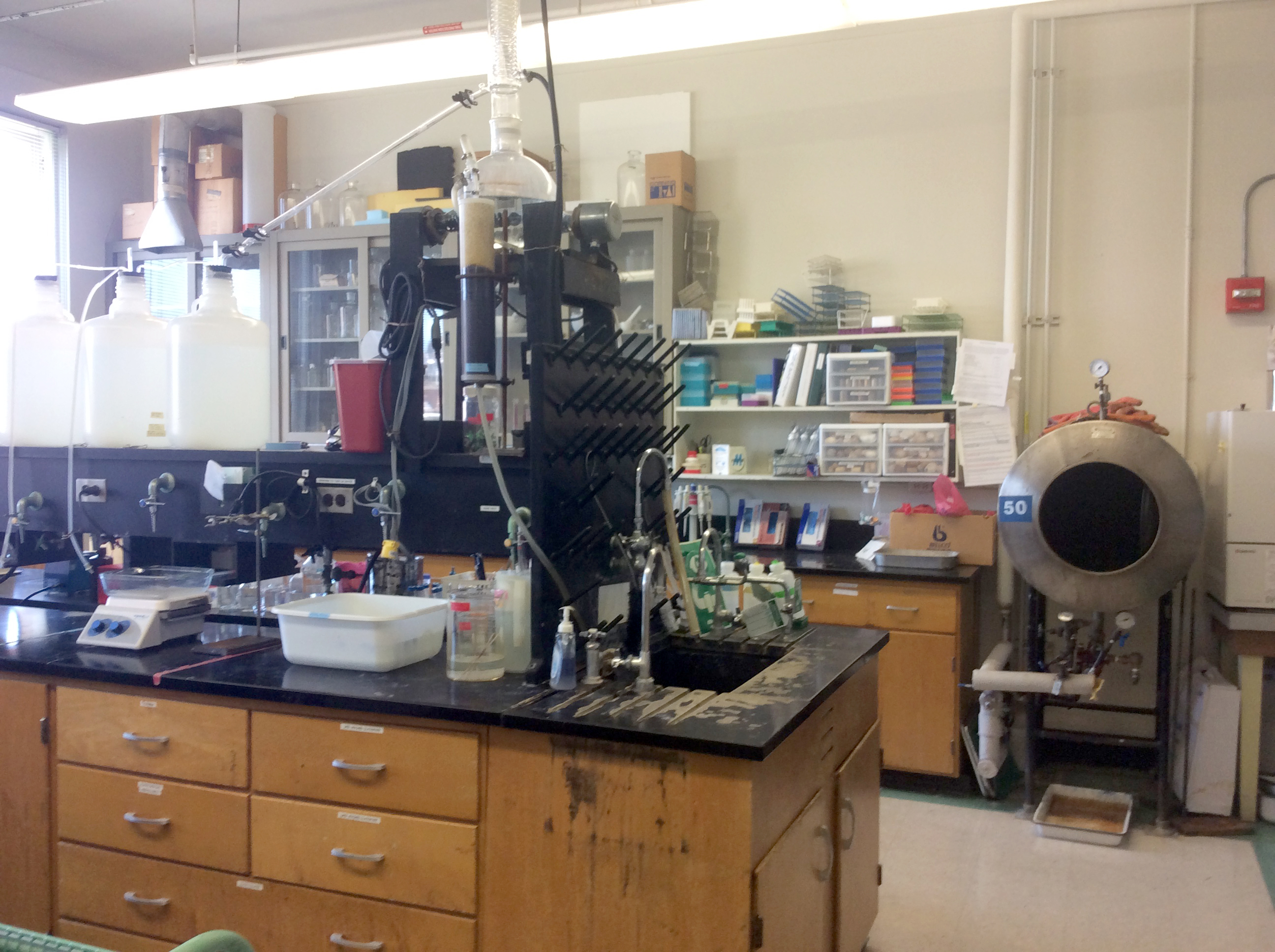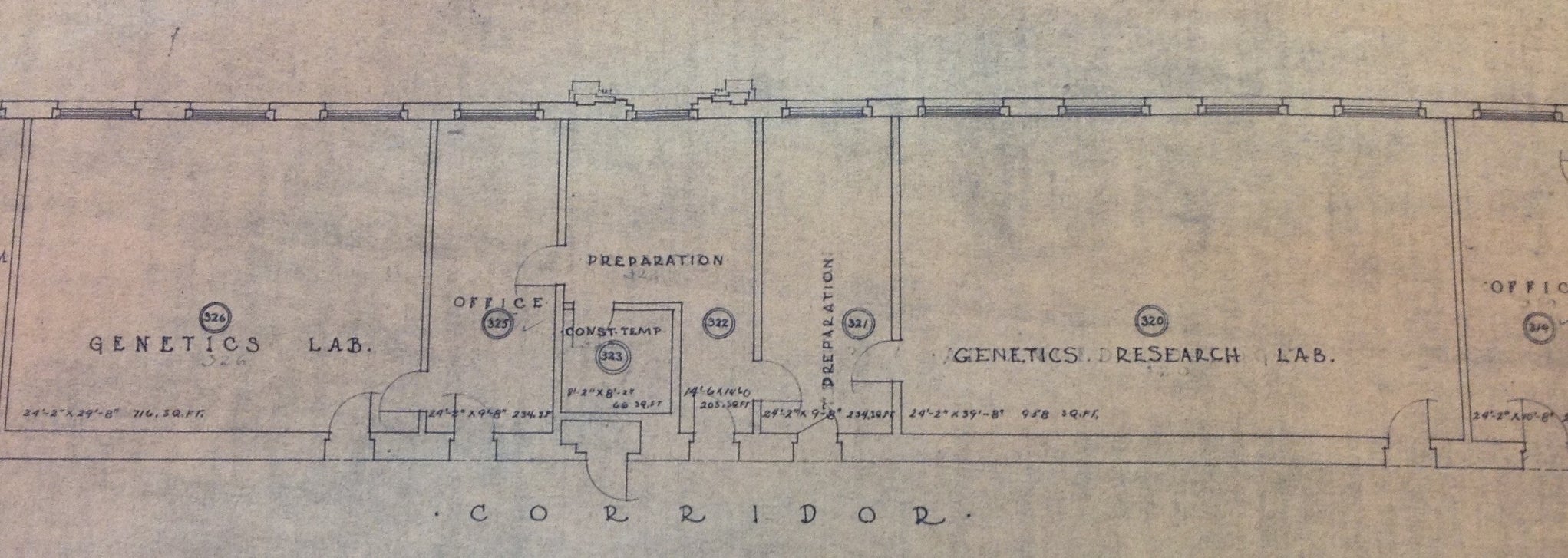
The photo of the Fly Room that launched the search. (Dolph Briscoe Center for American History)
A black and white photo started it all. Tucked in the old UT Zoology archives box at the Briscoe Center for American History, the back of it read: “Fly Room, 1940.” Along with it were photos of geneticist and Nobel Laureate Hermann Muller, who did much of his pioneering research in this room while at UT. As I took pictures of the photos, I wondered if this Fly Room still existed on campus. And if so, did anyone actually know where it was?
I kept pondering this question as I researched the life of Muller as part of the article I wrote about him. As the Fly Room was significant for UT’s historical involvement in ground-breaking science, I was determined to find it and see how time had changed it. There was something inherently fascinating to be able to stand in the room where he had done such significant work.
The original Fly Room was the Drosophila lab at Columbia University, active in the early 20th century. This room was small, 16’ x 23’, and despite its general untidiness, was considered a place of great collaborative discussion and research. Muller got his start in this lab, under the supervision of evolutionary biologist and geneticist Thomas Hunt Morgan.

Dr. Thomas Hunt Morgan's Fly Room, 1914. (American Society for Cell Biology)
Wowed with Muller’s work in genetics, UT zoology chairman John Thomas Patterson, or Dr. Pat as he was known, recruited Muller in 1920 to the growing staff in the Department of Zoology. Wanting to push Texas genetics forward, he arranged for Muller to have a larger Fly Room, with the intention of mimicking and even outdoing Morgan’s lab. This room came to be in 1925, when the Department of Zoology moved from the cramped quarters of the third floor east wing in the Old Main Building and into an entirely new building called the Biological Laboratories.

Muller in 1922. (Arizona State University)
Patterson made sure Muller would have not only more space, but a new refrigeration unit as well. During scorching Texas summers, Muller previously had to set his bottles of flies in pans of water and drape them in wet cheesecloth to keep them cool. Otherwise, the heat would sterilize them. This new lab became the one in which Muller made his landmark research between 1926-32 on the physiological and genetic effects of radiation on the fruit fly Drosophila, and was able to induce high numbers of mutations in a rapid span of time. X-rays had been used in both medicine and experiments in physics since 1895, but Muller’s discoveries in how radiation affected single genes really made their use valuable in genetics research. Muller recognized that genetic manipulation like this could be used in agriculture, industry, and medicine. So, his work in the Fly Room would bring the space quite a bit of notoriety.
The 1940 Briscoe photo I had of the room did not indicate a room number, so my search started with asking some of the active senior faculty and retired faculty members. Many suggested it might be in the Patterson Labs building, but since Muller had left UT permanently in 1932, and Patterson was not completed until 1969, I crossed that possibility off the list.
So, with a printout of the Fly Room photo in hand, I made frequent visits to the Biological Laboratories building, walking through the halls to try to match the doors. The first clue would be the door and the transom, the small window above the door that allowed airflow, as this building was without air conditioning during Muller’s time. However, as I was to find out, many of the old doors and transoms were covered over entirely, or obscured with lower ceiling tiles to hide the ductwork done in continued efforts to modernize the building.

Southwest side of BIO building, possibly 1940s. (Dolph Briscoe Center for American History)
Articles I found on Texas genetics and Muller gave additional important details. I learned there was one smaller room in the lab that was kept at a constant temperature of 69.8 degrees Fahrenheit in order to properly raise the flies during hot Austin summers. An article by geneticists James Crow and Robert Wagner, who worked in the Fly Room during the early years of their careers, also said the room was 72’ x 24’. Elof Axel Carlson’s excellent biography on Muller, Genes, Radiation and Society: The Life and Work of H.J. Muller, gave an additional photo of the Fly Room, this time with Muller at work with his jeweler’s loupe, along with Theophilus S. Painter, Wilson Stone, and Clarence P. Oliver, who all worked in the Fly Room.
Now with a measurement and another angle of the interior of the room, I was armed with new clues. However, using an online floor plan, I realized that larger rooms could have been remodeled into smaller ones over time. After I ran into biology professor Norma Fowler in the elevator and explained my search, she gave me a tour of some of the rooms, including her office, to show me how the original walls were built, versus the newly constructed sheetrock ones. There was a marked difference between the two. The original walls were constructed of lath and plaster, as opposed to the lighter sheetrock of modern walls. Consequently, the old walls had a picture rail molding, because driving a nail into a stud to hang a picture like we do today was not possible. Indeed, hitting an old wall felt like knocking on the backside of an elephant.

The Fly Room at UT. T.S. Painter sits in the rear left. C.P. Oliver looks at the camera, W.S. Stone stands in the back, and Muller is on the far right with his jeweler's loupe. (Indiana University, Lily Library)
Looking at the two Fly Room photos, I saw that the picture rail molding (the dark line at the top of the wall) and the exposed pipework were also a clue. I searched some of the larger labs to look at and measure pipework and the interior doors, before gently hitting the walls to see if they were the original lath and plaster or sheetrock. None of the larger labs fit the measurement of 72’ x 24’, as measured from original wall to original wall. Around this time, biology professor Jerry Brand said that when he started at UT in 1974, it was rumored that room 320 was Muller’s old Fly Room, but he didn’t have any other proof.
Dr. Norma Fowler suggested searching through Muller’s publications and any correspondence. The Lily Library at Indiana University contains the archive of Muller’s old papers and correspondence, and at my request, a librarian went through several boxes of files corresponding to his years at UT. Alas, we didn’t find a room number. I wrote directly to Elof Axel Carlson, the biographer, who spent a lot of time with Muller’s materials at Lilly, but he never returned my email.
Back to the drawing board.
Recalling there had been a zoology time capsule from 1953 in the Experimental Science Building that was demolished in 2008, I returned to the Briscoe Center to review the files there. I found Patterson’s 1925 publication The History of Biology at the University of Texas. This would have been published right at the time the Department of Zoology moved into the new building, so I flipped through it. At the very back page, Patterson gave me a lead in a section called “The New Biological Laboratory.” In addition to describing the use of the first, second, and attic floors, he wrote: “Research rooms and offices for the Zoology Staff are located on the third floor. In addition to these, laboratories for genetics, embryology, and advanced zoology, the constant temperature room, the library, and a small lecture room are located on this floor.”

Excerpt from J.T. Patterson's 1925 publication. (Dolph Briscoe Center for American History)
Finally, a clue! But then this: “The arrangement of rooms on the five floors is shown in the accompanying sketches of floor plans.” Search as I might, no floor plans were included in the time capsule, but at least I had confirmed the room was on the third floor.
The next step was to find the old UT directories for the zoology staff of the 1920s-30s, and perhaps either through direct listing or the process of elimination, I could locate the room amongst the larger lab rooms on the third floor. Returning to the Briscoe Center, I reviewed the old printed directories. Muller’s office was BIO 325, Painter was in BIO 310, Stone in BIO 314, Patterson took up the entire block of 316, and other zoology faculty were listed in the smaller offices, but still no notation of lab room numbers to differentiate the larger labs from one another.

Hermann Muller’s Office listing, UT Directory 1926, Dolph Briscoe Center for American History
I returned to the measurements of 72’ x 24’. All rooms were 24’ deep, but none were 72’ in length. All of the possible third floor rooms were shorter than this. I would have to find the old floor layouts, and through the help of the Briscoe librarians, they gave me the contact of the Alexander Architectural Archive, an architectural research center here on campus.
While I waited for the head librarian to return my inquiry, another huge clue fell into my lap. Biologist Dr. Larry Gilbert passed me Marshall Wheeler’s Looking Back: An Autobiography and Genealogy for archiving. Marshall Wheeler was a UT professor of zoology from 1947-77, best known as a taxonomist of insects worldwide, specifically those of the family Drosophilidae. I began to read about his life, flipping through his photos of serving in World War II—and there it was. In chapter seven, Wheeler wrote about his beginning years as a member of the zoology faculty in the 1940s, and stated: “I was assigned a desk in the room between the Office and the Library:…Just across the hall was the famous ‘Fly Room’ where I spent most of my time when not in class or holding office hours.”
I had to find Wheeler’s office room number and anxiously ducked back to the Briscoe Center to look up the 1940s UT directories. I found Wheeler’s listing: BIO 313. The Fly Room was across the hall, in any one of those rooms there. And then, the Alexander Archives returned my email. Seven images were attached, all of them third-floor plans from 1940. Looking over the images, I’d finally found what I was looking for. Room 320 was labeled: “Genetics Research Lab.” Room 321 and 322 were “preparation,” and the constant temperature room was labeled as room 323. With this map and with Wheeler’s comments from his autobiography, I’d finally found the Fly Room. The 72’ feet measurement from Wagner and Crow was either incorrect, or roughly encompassed this series of rooms.
Image from 1940 map of third floor of BIO building (Alexander Archives). Click on image to expand.
As soon as I could, I contacted the UTEX Culture Collection of Algae now housed in BIO 320, to allow me to take a look around the room again. I walked through the lab with an entirely different sense of appreciation. With the strong northern light pushing through the huge windows, I imagined Muller and his team studiously working almost a century ago in their starched shirts at their lab tables. I looked inside the tiny constant temperature room where thousands of fruit flies had existed at one time, safe from the brutal Texas summers, and spotted the original Sturtevant unit ventilator still attached to the wall, rusting, but still standing after all these years.
Special thanks to Ana Aguilar in UTEX Culture Collection of Algae, David Luna and Katherine Reynolds of CNS Spacerangers, Dr. Jerry Brand, Dr. Norma Fowler, Nancy Sparrow of Alexander Archives, and the wonderful librarians at the Dolph Briscoe Center for American History.

The Fly Room today where the UTEX Culture Collection of Algae is housed.

Left: Original door leading to constant temperature room. The door’s unusual heaviness and thickness indicates it also might have been where Muller’s X ray machine was housed. Right: Old Sturtevant unit ventilator for constant temperature room. This is the original cooling unit Patterson had installed in the room.




